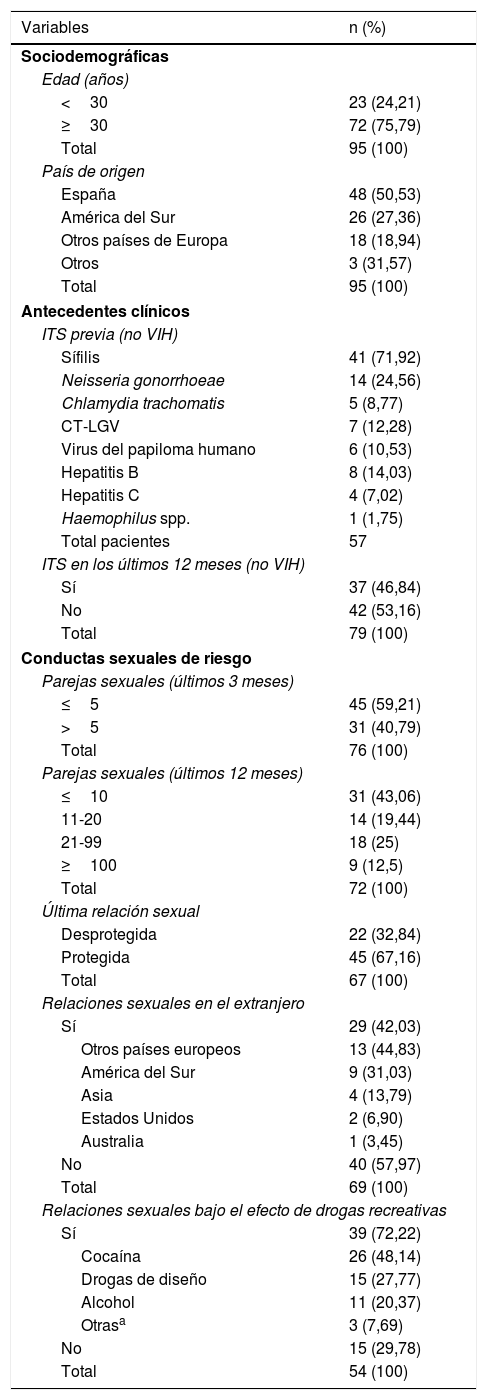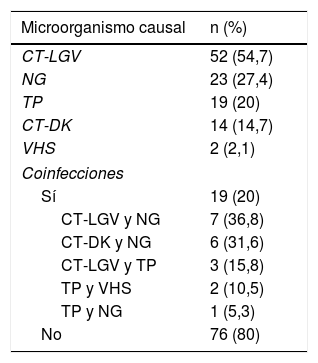Las infecciones de transmisión sexual con afectación anorrectal (ITS-AR) afectan principalmente a hombres que tienen sexo con hombres (HSH).
Material y métodosEstudio retrospectivo realizado en pacientes diagnosticados de ITS-AR en una unidad de ITS entre 2014 y 2015. Se recogieron datos epidemiológicos, microbiológicos, clínicos y de conducta sexual.
ResultadosSe analizaron 95 individuos, todos HSH. El 88,42% estaban infectados por el VIH; el 67,17% refirió que la última relación sexual fue desprotegida; el 17,91% tuvo sexo con trabajadores sexuales y, en el año previo, el 72,22% había consumido drogas previamente a las relaciones sexuales. El 32,92% presentaron sintomatología durante más de 30 días. El 54,73% de los diagnósticos fue linfogranuloma venéreo (LGV). Todos los pacientes que consultaron por úlcera asociada a proctitis presentaron infección por LGV. Todos los que consultaron por úlcera perianal sin proctitis asociada fueron diagnosticados de sífilis.
ConclusionesTodos los pacientes con ITS-AR fueron HSH, la mayoría positivos para el VIH, con conductas sexuales de riesgo y un tiempo de evolución largo. Las características clínicas, epidemiológicas y microbiológicas de las ITS-AR en nuestro entorno podrían ayudar a ajustar mejor el tratamiento empírico.
Sexually transmitted infections of the rectum and anus (STI-RA) mainly affect men who have sex with men (MSM). The incidence of STI-RA among them has increased in recent years.
Material and methodsRetrospective study in patients with diagnoses of STI-RA in an STI unit during the years 2014 and 2015. Epidemiological, clinical and microbiological data were collected.
ResultsWe included 95 patients, all of whom were MSM; 88.42% were HIV+; 67.17% did not use a condom during their most recent sexual intercourse; 17.91% had had sex with sex workers and 72.22% had used drugs during sexual intercourse during the previous year. A percentage of 32.92 reported symptoms that had lasted longer than 30 days. Lymphogranuloma venereum (LGV) was diagnosed in 54.73% of the patients. All patients who presented with proctitis and perianal ulcers were diagnosed with LGV infection. All those who presented perianal ulcers without proctitis were diagnosed with syphilis.
ConclusionsAll the patients affected by STI-RA were MSM, most of them HIV+, had engaged in high-risk sexual behaviour and had suffered prolonged symptomatology. Clinical and microbiological characteristics of STI-AR could help adjust the empiric therapy.
Artículo
Comprando el artículo el PDF del mismo podrá ser descargado
Precio 19,34 €
Comprar ahora








